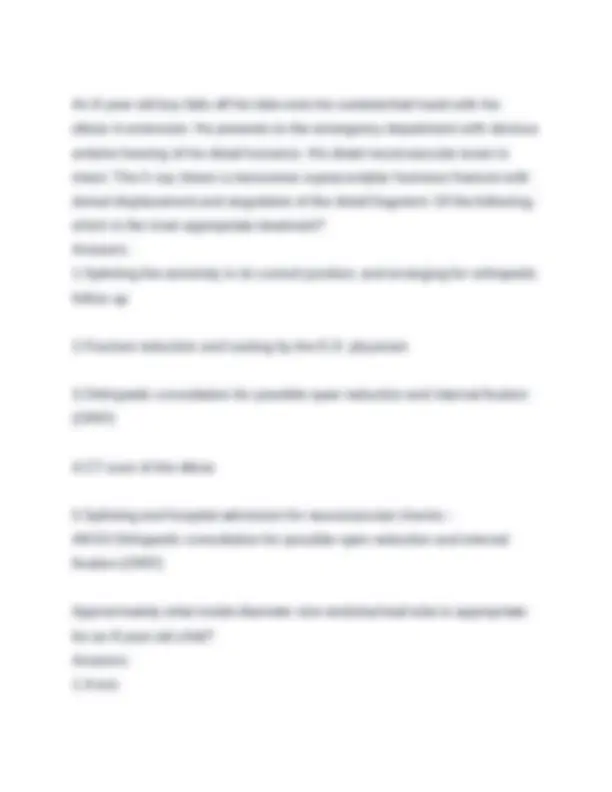












Study with the several resources on Docsity

Earn points by helping other students or get them with a premium plan


Prepare for your exams
Study with the several resources on Docsity

Earn points to download
Earn points by helping other students or get them with a premium plan
Community
Ask the community for help and clear up your study doubts
Discover the best universities in your country according to Docsity users
Free resources
Download our free guides on studying techniques, anxiety management strategies, and thesis advice from Docsity tutors
SAEM Peds Test Latest Edition 2025-2026. Questions & Correct Answers. Graded A
Typology: Exams
1 / 18

This page cannot be seen from the preview
Don't miss anything!











A 12-day-old term infant presents for evaluation of vomiting blood-streaked emesis once after feeding. She is well appearing and well hydrated with normal vital signs and an unremarkable exam. She is breast-fed. What should the physician do next? Answers: 1.Ask the mother if she has any bleeding from her nipples. 2.Begin a septic workup. 3.Start a workup for a bleeding diathesis. 4.Start an H2 blocker for reflux. - ANS1.Ask the mother if she has any bleeding from her nipples. A 17 year old boy injured his right shoulder playing football. He tried to arm- tackle a player when his right arm was pulled away from his body and back (abducted and extended). He felt a sudden pain in his shoulder. He presents to the emergency department holding his arm in slight abduction and external rotation by his good arm. He has severe pain with adduction or internal rotation. What is the most common fracture associated with this injury? Answers:
1.Compression fracture of the posteriolateral aspect of the humeral head (Hill-Sachs deformity) 2.Avulsion fracture of the greater tuberosity of the humerus 3.Clavicle fracture 4.Acromioclavicular joint separation 5.Fracture of the anterior glenoid lip (Bankart's fracture) - ANS1.Compression fracture of the posteriolateral aspect of the humeral head (Hill-Sachs deformity) A 2 year old is brought in to the emergency department by his mother for difficulty breathing. The mother thinks he might have swallowed or aspirated something. In regards to this patient, which of the following is TRUE regarding foreign body aspiration or ingestion? Answers: 1.Large objects in the upper airway typically present with mild symptoms 2.Objects lodged in the proximal airway have the worst prognosis 3.Small objects in the lower airways typically present with the most severe symptoms 4.The most difficult objects to remove are stiff, non-conformable objects - ANS2.Objects lodged in the proximal airway have the worst prognosis
4.give him antibiotics for infectious diarrhea - ANS3.arrange for a barium enema and surgical consultation A 5 year old child was eating an almond when he experienced sudden, intermittent bouts of choking and wheezing. Assuming this child aspirated an almond, which of the following is most likely to be seen on chest X-ray? Answers: 1.Atelectasis of the affected lung 2.Diaphragmatic flattening of the non-affected lung 3.Foreign body in the shape of an almond 4.Hypoinflation of the non-affected lung - ANS1.Atelectasis of the affected lung A 7 year old boy falls off his bike onto his outstretched arm and sustains a supracondylar fracture. The fracture originates in the metaphysis and a portion of it extends into the physis (growth plate) without extending through to the epiphysis. How is this fracture classified? Answers: 1.Salter I 2.Salter II 3.Salter III
4.Salter IV 5.Salter V - ANS2.Salter II A mother brings her 3 year old daughter into the emergency department for an arm injury. The mother was holding her hand to cross a busy street. She pulled hard on her daughter's arm to hurry across the street and the child began to cry. Since the incident the child has kept her arm against her body in a slightly flexed and pronated position. She is tender over the radial head and refuses to move her elbow, but there is no swelling or ecchymosis. What is the most appropriate management for this girl? Answers: 1.Obtain immediate X-rays of the elbow to rule out fracture 2.Obtain immediate orthopaedic consult for presumed elbow dislocation 3.Apply posterior elbow splint and follow-up with orthopedics within one day 4.Apply pressure to the radial head while flexing and supinating elbow 5.Apply traction to elbow and splint under conscious sedation - ANS4.Apply pressure to the radial head while flexing and supinating elbow A newborn presents to the emergency department a few days after hospital discharge. The infant has been noted to be drooling, choking, and
5.any inability to ventilate by bag-valve-mask methods or the need for prolonged control of the airway - ANS2.gastric distension due to excessive volume or rate of ventilation impairing ventilatory function All of the following are true regarding chest compressions in the infant EXCEPT: Answers: 1.An appropriate position for performing chest compressions is to encircle the chest with both hands and place the thumbs side by side on the sternum. 2.Chest compressions should be initiated whenever an infant's heart rate is less than 60 bpm. 3.Compressions should be performed at a rate of 90 per minute. 4.Chest compressions should be accompanied by a ventilatory rate of 30 per minute. 5.Correct depth of compressions is one-third the anteroposterior diameter of the chest. - ANS2.Chest compressions should be initiated whenever an infant's heart rate is less than 60 bpm. All of these steps are involved in pediatric rapid sequence intubation (RSI) EXCEPT: Answers:
1.If administering succinylcholine, pretreatment with atropine is always indicated in children under age 10. 2.Lidocaine pretreatment is usually provided to children with head trauma. 3.When deciding which size endotracheal tube to use, one may approximate by using the size of the small finger or nares as a reference. 4.Due to the fragility of the pediatric C-spine, a cervical collar should always be placed prior to intubation for children under age ten. 5.Uncuffed endotracheal tubes are the preferred devices used in children under 6-8 years of age. - ANS4.Due to the fragility of the pediatric C-spine, a cervical collar should always be placed prior to intubation for children under age ten. All the following are signs of hypoxemia in a newborn, EXCEPT: Answers: 1.cyanosis 2.lethargy 3.tachycardia 4.unresponsiveness 5.bradycardia - ANS3.tachycardia
2.6 mm 3.8 mm 4.10 mm 5.12 mm - ANS2.6 mm hich of the following vital signs is a cause for concern in the term newborn? Answers: 1.heart rate of 165 2.respiratory rate of 50 3.heart rate of 95 4.respiratory rate of 70 5.systolic blood pressure of 65 - ANS3.heart rate of 95 In pediatric resuscitation the following drugs may be given by the endotracheal route, EXCEPT: Answers: 1.epinephrine 2.naloxone
3.digoxin 4.atropine 5.lidocaine - ANS3.digoxin In the post-arrest setting, which of the following is the drug of choice in treating hypotension in a child: Answers: 1.epinephrine infusion 2.dobutamine infusion 3.dobutamine bolus 4.dopamine infusion 5.nitroprusside infusion - ANS1.epinephrine infusion Low body temperatures in newborns can lead to severe physiologic consequences, which include all EXCEPT: Answers: 1.metabolic acidosis 2.increased oxygen consumption 3.hypoglycemia
5.hyperthermia - ANS1.hypoxemia Regarding pediatric head injury, all the following are true EXCEPT: Answers: 1.Head trauma is the leading cause of death among injured children. 2.A child's cranial vault is larger and heavier in proportion to its total body mass than an adult's. 3.Pediatric epidural hematomas are venous in origin. 4.A brief seizure occurring immediately after the insult, with rapid return to normal level of consciousness is usually unassociated with intracranial parenchymal injury. 5.Retinal hemorrhages are a common finding in mild-moderate trauma. - ANS5.Retinal hemorrhages are a common finding in mild-moderate trauma. What is the most common category of shock in the pediatric population? Answers: 1.hypovolemic 2.distributive 3.cardiogenic
4.obstructive 5.dissociative - ANS1.hypovolemic What is the most common heart rhythm seen in pediatric arrest? Answers: 1.bradycardia 2.ventricular fibrillation 3.paroxysmal atrial tachycardia 4.Wolff-Parkinson-White syndrome 5.atrial fibrillation Points achieved: 0Incorrect - ANS1.bradycardia Which of the following describes the most commonly indicated initial approach in neonatal resuscitation? Answers: 1.dry, warm, position, suction, stimulate 2.chest compressions 3.medications
4.tongue 5.maternal drugs - ANS5.maternal drugs Which of the following is NOT suggestive of perinatal asphyxia? Answers: 1.umbilical artery academia (pH < 7.00) 2.5-minute Apgar score of 5- 3.neonatal neurological sequelae 4.multiorgan dysfunction 5.5-minute Apgar score of 3 or less - ANS3.The pediatric airway is more posterior than the adult airway. Which of the following is the commonest type of pediatric rhythm in the setting of cardiopulmonary arrest? Answers: 1.supraventricular tachycardia 2.ventricular tachycardia 3.atrial flutter 4.atrial fibrillation
5.asystole - ANS5.asystole Which of the following methods is NOT used to establish the correct endotracheal tube size in a pediatric patient over 1 year of age: Answers: 1.(age in years + 16) divided by 4 2.approximation with child's little finger 3.age in months divided by 3 4.approximation with child's nares 5.body length using a Broselow emergency tape - ANS3.age in months divided by 3 Which of the following pairs of maneuvers are consistent with current recommendations for emergency care for a choking 5-month-old infant? Answers: 1.back blow then blind finger sweep 2.back blow then chest thrust 3.chest thrust then Heimlich maneuver 4.Heimlich maneuver then blind finger sweep